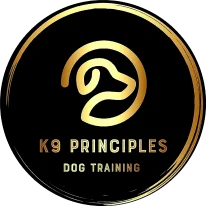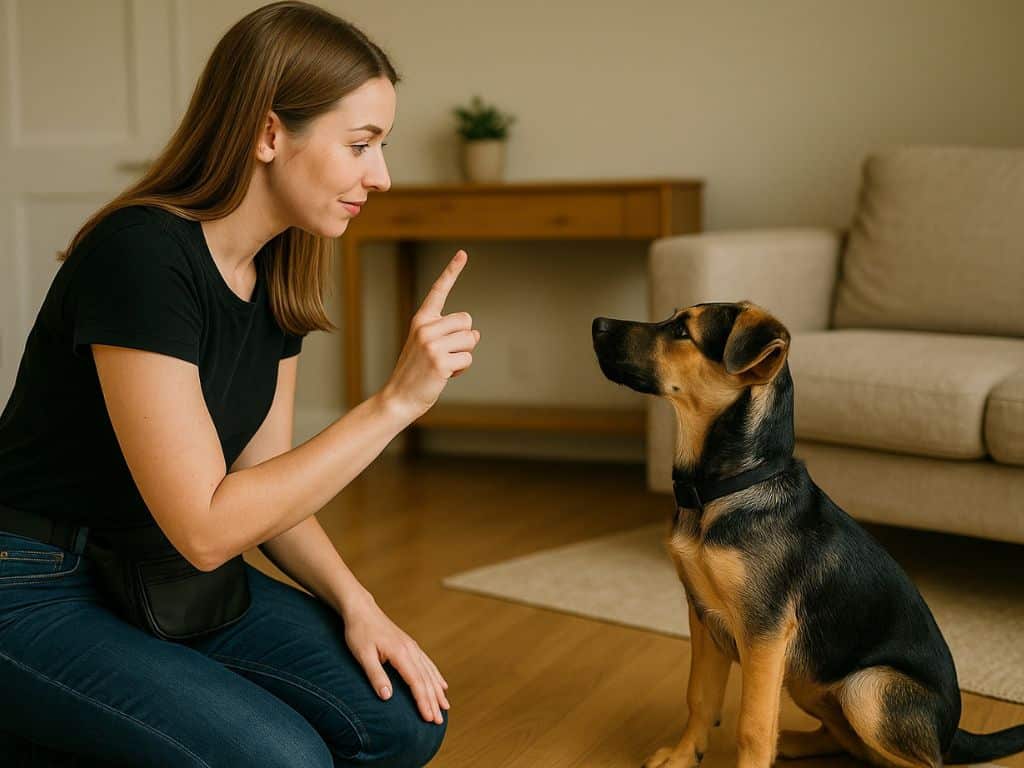There’s a phrase that gets thrown around in dog training circles all the time — practice makes perfect. It sounds motivating, but it’s not actually true. When we say it here at K9 Principles, what we really mean is something far more powerful: practice makes permanent. Because what you rehearse becomes your dog’s reality. And if you’re new to this, this concept could be the single most important thing you ever learn about dog training in Hamilton.
If you’re raising your very first dog, it can feel like you’re always trying to get things right. The lead gets tangled, the recall doesn’t work, the sit only happens if you’ve got a treat in your hand. It’s easy to think perfection comes from practising over and over. But dogs don’t magically get better from mindless repetition — they get better from correct repetition. Whatever they practise, they’ll get really good at… even if it’s the wrong thing. That’s the power of this principle, and why it can transform your approach to dog training forever.
Understanding What ‘Practice Makes Permanent’ Really Means
Think about it like writing your name. When you first learned as a child, you wrote it awkwardly, slowly, maybe even backwards. But over time, you did it so often that your muscles learned what to do. Now, you can sign your name without even thinking. That’s what happens to your dog every time they repeat a behaviour — good or bad.
“Practice makes permanent” means that repetition wires behaviour into your dog’s brain and body until it becomes automatic. If your dog jumps on people and it works to get attention, that behaviour will stick. If they sit calmly and get rewarded for it, that will stick too. This isn’t about striving for perfection. It’s about realising that every repetition matters because everyone is building permanence. This principle is the backbone of the way we approach Hamilton dog training here at K9 Principles.
Why This Principle Matters in Early Training
When your dog is young or new to your home, their brain is like wet cement. Every experience leaves a mark. The early days are when they’re forming associations, routines, and expectations about how the world works. That’s why these first weeks are the most powerful window to set patterns.
If you allow them to rehearse things like pulling on lead, dashing out the door, barking out windows, or ignoring cues, those behaviours become habits fast. But if you structure their environment so they can only rehearse the behaviours you want, you build strong, reliable foundations. It’s why we put such a heavy emphasis on management and structured setups during the early stages of dog training in Hamilton. The more clean, correct repetitions your dog gets early on, the easier everything else becomes later.
How Repetition Shapes Your Dog’s Brain and Behaviour
Here’s the fascinating part: every time your dog performs a behaviour, it strengthens the neural pathways that control it. Think of it like carving a trail through a forest. The more you walk that path, the clearer and faster it becomes. If you stop using it, it fades. But if you keep using it, it becomes the easiest route to take. 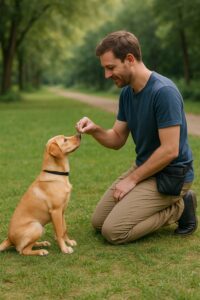
This is why consistency is so powerful in dog training. Your dog’s brain physically adapts to the behaviours they practise most. Sit becomes faster. Recall becomes snappier. Calm behaviour becomes their default. What feels like magic is just neuroscience — repetition rewires the brain. When we’re teaching dogs at K9 Principles, we use this to our advantage, making sure the behaviours your dog repeats are always the right ones.
Good Habits vs Bad Habits — Why Dogs Don’t Know the Difference
Here’s something that surprises most first-time owners: your dog doesn’t know if a behaviour is “good” or “bad.” They just know what works. If barking at the delivery driver makes them go away, they’ll do it again. If jumping earns attention, they’ll jump more.
Dogs are brutally honest learners. They repeat what gets them results. That’s why unintentional practice is one of the biggest problems we see in Hamilton dog training. A behaviour doesn’t have to be encouraged to be practised — it just has to be allowed. Every repetition strengthens it, and dogs will happily practise the wrong thing if it gets them something they want. That’s where your awareness becomes their greatest teacher.
The Hidden Risks of Practising the Wrong Behaviour
When a dog rehearses an unwanted behaviour, they’re not just trying it out — they’re making it their habit. Every repetition makes it harder to change later. This is why prevention is so much easier than correction. 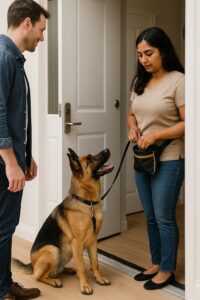
If a dog spends weeks pulling on a lead, their brain becomes wired for pulling. If they practise ignoring a recall, that becomes their default. This is why we emphasise structured setups at K9 Principles. We don’t wait for bad behaviours to happen so we can correct them. We prevent them from being rehearsed at all, so they never get the chance to become permanent. It’s one of the most effective ways to get reliable results with your dog training in Hamilton.
Quality Over Quantity: Perfecting the Repetitions
Many owners assume more practice equals better behaviour. But if your dog practises it wrong, you’re just making the wrong version permanent. Five perfect repetitions are worth more than fifty sloppy ones.
This is why we keep early sessions short and focused. Dogs learn fastest when they succeed. If they start making mistakes, they’re getting better at the mistakes, not the skill. Stopping before that happens means only the correct version gets practised. That quality-over-quantity approach is the heart of how we teach new behaviours during Hamilton dog training sessions with K9 Principles.
How We Apply This at K9 Principles for Dog Training in Hamilton
We design every training plan to make correct behaviour easy and incorrect behaviour impossible. When we introduce a new cue, we start in a quiet space where your dog can’t fail. We reward heavily for each success. Then, we slowly add distractions as your dog becomes fluent.
This layered approach means your dog only practises success. There’s no frustration, no confusion, just confidence building step by step. It’s why our clients see such fast progress during dog training in Hamilton. By controlling what your dog rehearses, we control what becomes permanent — and we make sure it’s the behaviours you actually want.
Consistency Builds Confidence — And Confidence Builds Reliability
Dogs love patterns. Knowing what to expect helps them feel secure. Every consistent interaction from you is like a signpost saying, “Yes, you’re on the right track.” That confidence makes them more willing to try, which makes them learn faster.
When training is inconsistent — sometimes rewarded, sometimes not, sometimes enforced, sometimes ignored — dogs get anxious and uncertain. They guess, they hesitate, or they just stop trying. But when everything is predictable, they throw themselves into learning. This is why consistency is one of the most powerful tools in dog training, and why it’s such a core part of what we teach at K9 Principles.
Why Timing Is Everything When You Practise
Dogs learn by association. The faster you mark and reward a behaviour, the stronger the link becomes in their brain. A reward given three seconds late is rewarding whatever they’re doing then, not what they did three seconds ago.
This is where so many new owners get stuck. They wait too long to reward, and their dog doesn’t connect the dots. Practising with perfect timing makes sure your dog is learning the behaviour you actually want, not something random they did after. When you practise with us at K9 Principles, we’ll teach you how to use perfect timing to make your dog’s learning lightning fast during Hamilton dog training sessions.
Breaking Old Patterns: Making New Practices Stick
What if your dog already has some unwanted habits? Don’t panic. Permanence works both ways. You can overwrite old patterns by preventing the old behaviour from being rehearsed while you build a new one to replace it.
It’s like taking the old forest path and blocking it off while you cut a new trail. At first, it’s slow and awkward. But the more you use the new trail, the easier it gets — and the old one fades away. This is how we approach behaviour change in dog training in Hamilton at K9 Principles. With patience, structure, and correct repetitions, even long-standing habits can be rewritten.
How to Prevent Accidental Practice of Unwanted Behaviour
One of the easiest ways to stop bad habits forming is to prevent your dog from rehearsing them at all. That means using leads, baby gates, management tools, or controlled setups to make sure your dog can only succeed.
For example, if your dog jumps on guests, keep them on lead when people arrive. Practise calm sits for greetings and reward them generously. Soon, sitting becomes the default. This is how you flip “practice makes permanent” from a problem into a powerful tool — something we focus on heavily during our Hamilton dog training sessions at K9 Principles.
Shaping Behaviours One Small Step at a Time
Shaping is the art of rewarding small steps toward the final behaviour. Instead of waiting for the perfect sit, you reward the attempt. Instead of waiting for a full recall, you reward them for just turning their head at first.
This lets your dog experience constant success, and success builds motivation. It also prevents them from practising mistakes, because every step is guided and reinforced. This gradual approach is one of the most reliable ways to build permanence, and it’s a cornerstone of how we train at K9 Principles while we are dog training in Hamilton.
Proofing Skills So They Last in Real-Life Settings
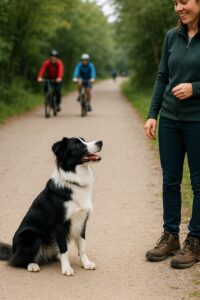 A behaviour isn’t truly permanent until it works everywhere, not just at home. This is where proofing comes in — practising in different places, with different distractions, until your dog can do it anywhere.
A behaviour isn’t truly permanent until it works everywhere, not just at home. This is where proofing comes in — practising in different places, with different distractions, until your dog can do it anywhere.
Without proofing, you only get location-specific behaviour. With proofing, you get real-world reliability. We take our dogs into parks, trails, and busy Hamilton streets to proof every behaviour. This ensures your dog can succeed even when life gets exciting. It’s the final step in turning practice into permanence during Hamilton dog training.
The End Result: Calm, Reliable Behaviour That Lasts
When every repetition is correct, consistent, and rewarded, something magical happens. Your dog stops thinking so hard. They just do it. Sit, stay, recall, calmness — it all becomes their default because it’s been rehearsed so well.
This is what we mean by “practice makes permanent.” It’s not about drilling them until they’re perfect. It’s about building such strong habits that the behaviour becomes who they are. And that’s what we help you achieve here at K9 Principles through structured, thoughtful dog training in Hamilton.
Conclusion: The Harmony You Can Create

Here at K9 Principles, that’s exactly what we teach. We’ll guide you through structured, positive, and effective Hamilton dog training that builds habits you can count on — for life. Because practice doesn’t make perfect. Practice makes permanent.
Contact us for more information:
- Name: K9 Principles
- Address: Haldimand County, Greater Hamilton Area, Burlington, and Most of Norfolk County
- Phone: 289 880-3382
- Email: k9principlesinc@gmail.com
- Website: www.k9principles.ca
FAQs
-
A1. It means that whatever your dog rehearses becomes their default behaviour, whether it’s good or bad.



